You can buy chickens when they are still chicks, or you can choose ‘point of lay’ hens (also known as started pullets). These are ready-to-go birds that are about to begin laying eggs, and they offer the easiest entry into the wonderful world of chicken keeping.
If you choose to buy chicks or hatch fertilized eggs laid by your own hens, you will have to care for the young birds for the five months before they start laying. They are extremely cute but delicate little things, and easy prey for cats, rats and other creatures that wouldn’t attempt to attack a full sized hen. You will also need to keep them warm, which means investing in special equipment.
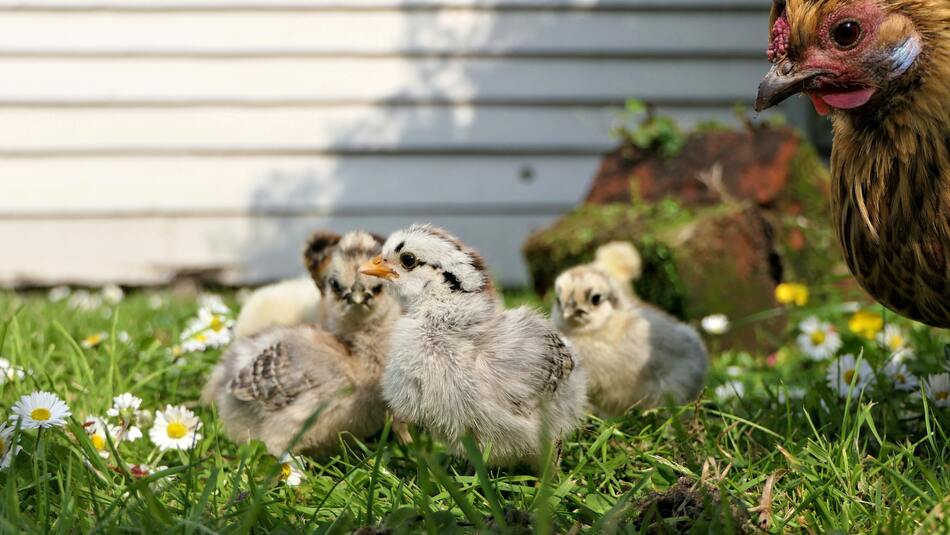 Photo by Andrea Lightfoot on Unsplash
Photo by Andrea Lightfoot on Unsplash
So, if you are simply keeping chickens for fresh eggs, you should start with adult birds rather than chicks.
Why buying point-of-lay hens?
This is the entry point for most people who are new to keeping chickens. By checking availability in your local area, you will be able to source birds close to home. The advantages of choosing these older birds pretty much outweigh all other options, and the only reason you would opt for buying or hatching chicks is if you want to look after small birds. For many people, this is a very rewarding activity, but for someone who just wants to look after laying hens, started pullets are the way forward.
Why keeping ex-barn hens?
Another great way to stock your coop is with rescued chickens. Intensively reared hens kept in barns are judged to be past their prime after a year and a half, even though they still have a good 18 months of laying ahead of them. For the majority, this is the end of the road.
All ex-barn hens have great charm and personality. They tend to look rather bedraggled and sad when first rescued from their imprisonment, but with a bit of TLC they will blossom as impressively as the Ugly Duckling!
Some ex-barn hens may arrive with a limp, and most of them will look half-plucked, but they will soon recover their composure, and – as most of these chickens are ‘disposed of’ at less than 18 months old – they will still give you a couple of years of good laying.
What do I need to know about buying chicks?
You need to be sure that you buy baby hens and not cockerels. There are no external clues as to what sex a chick is, and any stock sold sight unseen (or ‘straight run’) will be a 50/50 mix of male and female birds. You need the chickens to be sexed to ensure you get hens. If this is not possible, wait for started pullets to become available.
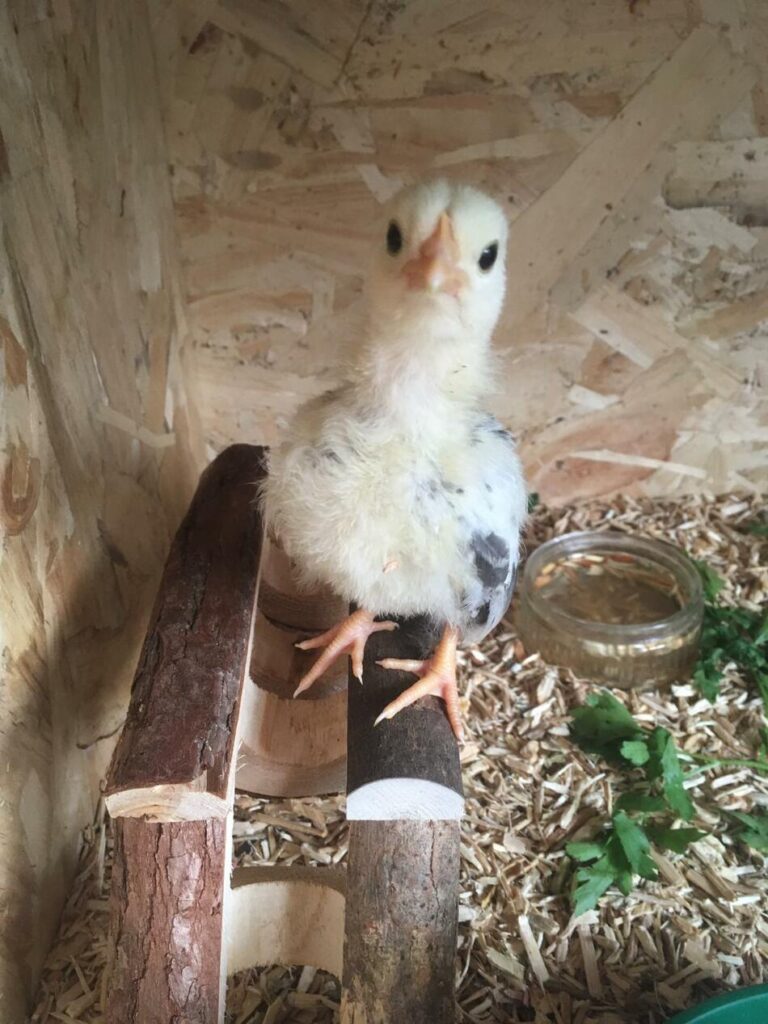 Chicks need special accommodation for the first few weeks, and they can’t simply be kept in a standard coop and run. You can buy brooder boxes to keep them, or you can improvise one using a cardboard box or plastic bin with holes in the side. The important thing is to keep the birds warm and protect them from drafts while ensuring good ventilation. You will need two square feet per chick to ensure they have enough room when they get bigger – which they will do, very quickly.
Chicks need special accommodation for the first few weeks, and they can’t simply be kept in a standard coop and run. You can buy brooder boxes to keep them, or you can improvise one using a cardboard box or plastic bin with holes in the side. The important thing is to keep the birds warm and protect them from drafts while ensuring good ventilation. You will need two square feet per chick to ensure they have enough room when they get bigger – which they will do, very quickly.
The chicks need to be kept in a temperature of 35C (95F) in their first week. The heat should be reduced slightly each week until you’ve reached room temperature. A heater designed for coops and aviaries is the best buy. A red heat bulb is another option (not a white one – these produce glare that keeps chicks awake at night and tends to make them irritable and prone to pecking). Standard light bulbs will not do the job.
After installing your chicks, pay close attention to how they behave. If they’re crowded together directly under or adjacent to the heat source, they’re cold. Lower the heat source or add another. If, on the other hand, they shy away from it, they’re too hot. In this case, the heater or bulb will need to be moved further away.
What do I need to know about chicken brooders?
You can buy brooder boxes to keep chicks in, or can make one yourself using a cardboard box or plastic bin with holes in the side. The important thing is to keep the birds warm and protect them from drafts, while ensuring good ventilation.
The chicks need to be kept in a temperature of 35C (95F) in their first week. The heat should be reduced slightly each week until you’ve reached room temperature. A heater designed for coops and aviaries is the best buy. A red heat bulb is another option (not a white one – these produce glare that keeps chicks awake at night and tends to make them irritable and prone to pecking). Standard light bulbs will not do the job.
Very young chicks will need to have their water changed at least twice a day, as they have the uncanny ability of turning all liquids to messy soups within a few hours! They also need their bedding changed at least once a week. A chicken wire covering for the top of the brooder is advisable, too. Chicks can easily ‘fly the nest’ if the sides of the brooder are less than 45cm high.
Chicks can spend a little time outdoors when they’ve reached two weeks. A large wire cage or some other type of portable enclosure can be placed outside for a few hours a day – but only if it’s at least 18C (65F) and not too windy, and dry. The birds will need food, water and shade, and shouldn’t be left alone for very long. Predators are everywhere when you’re a small chick!
Once they’ve reached four to five weeks, the chicks can be moved permanently into the outdoor chicken run.
Do I want to breed my own chickens?
Another way of keeping chickens is to keep the flock refreshed by hatching eggs from their own chickens. The easiest way of raising chickens is to let nature take its course. All you have to do is provide a nest box for a broody hen. She will provide the right conditions for hatching eggs (although she will not be able to cope with more than a dozen at a time, or fewer with smaller breeds), warming and turning them as necessary. An incubator is the alternative hatching method.
A cockerel will do everything in his power to tread the hens in his flock and fertilize the eggs. If a chicken is broody, she will then sit on the eggs for 21 days (the incubation period), and with a bit of luck these eggs they will then hatch.
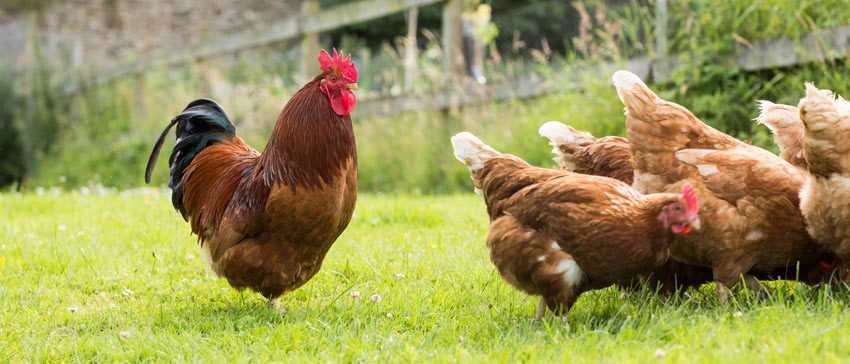
Rearing chicks is a great hobby, but you need to be dedicated to the job. If all you want is fresh eggs and a flock of healthy, happy adult chickens, wait for point-of-lay birds to become available, or contact the BHWT for some of those rescue hens in need of a good home.
This entry was posted in Chickens on February 28th, 2021 by alisa.deluca
Older rabbits need a little extra care. But when exactly is a bunny ‘old’? It very much depends on the breed. Larger rabbits have shorter lifespans than smaller ones, which means they become senior rabbits sooner than medium and small breeds.
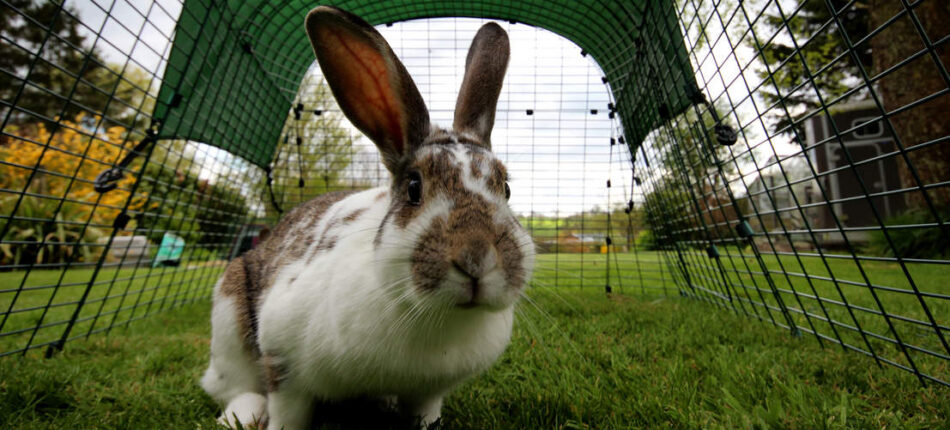
At what age is a rabbit considered old?
As a general rule of thumb, small rabbit breeds, which live around 12 years, are seniors when they reach 8. Medium-sized rabbit breeds live up to 10 years and can be considered senior at 6 years. The large rabbit breeds have much shorter lifespans – just 4 to 7 years – and reach old age at 4.
The shortest-lived rabbit breeds are like small pets such as gerbils, hamsters and rats, in that they only have a few months of senior status at the end of their lives.
How do you take care of an old rabbit?
Here’s how to make sure those senior rabbit years are as healthy and happy as possible.
Make sure you give them the right food
Rabbit care is largely about food, and a healthy diet is essential throughout a rabbit’s life. As your bunny gets older, you should consider buying specially formulated pellets or nuggets. There are several different brands, and they contain the optimal balance of vitamins and minerals for ageing rabbits. Older rabbits mustn’t gain too much weight – or, indeed, lose weight – during this dietary transition, so you should weigh them regularly to maintain the correct weight. In addition to the special pellets, senior rabbits should be fed lots of hay and fresh foods as usual.
Don’t add supplements to your rabbit’s diet
Rabbits get everything they need from a diet of hay, fresh food and appropriate pellets. Extra calcium, for example, can cause digestive problems or stones in the urinary tract.
Make sure your bunny gets plenty of exercise
Getting old doesn’t mean sitting around all day – rabbits of all ages need to move around to stay happy and healthy. A run will naturally allow your bunnies to hop, skip and jump, and a tunnel layout such as Omlet’s Zippi system is nothing short of essential. These run layouts keep your rabbit exercised both mentally and physically, which is all part of healthy old age. You can use rubber-backed mats on steep or slippery surfaces, to enable the rabbit to get a better grip.
Provide quiet spaces
Senior rabbits are less active than young bunnies and appreciate a quiet space away from the action. A cosy corner in the hutch will keep a tired rabbit happy, with lots of soft bedding, is essential. Incorporating ‘safe spaces’ in your run helps too. If you use a Platform, the space created has the dual purpose of providing a quiet corner high up in the run, and also gives your pet rabbit exercise as it climbs up and down.
Keep the hutch lined with soft bedding
Senior rabbits can develop pressure points and sores or a foot condition called pododermatitis. This is caused by hard surfaces or wire meshing on the floor of a run. Good senior rabbit care means looking after sore feet!
Keep bunny claws clipped
Senior rabbits tend to move around less, and as a result their claws can soon become overlong. Regular clipping is required. If you’re not comfortable performing this, ask your vet for help.
Provide shelter from the elements
In addition to that cosy corner in the rabbit’s hutch, some weatherproofing to shield your ageing bunny from the elements will increase the comfort factor, whatever the weather. A Zippi Rabbit Run Weather Protection cover is the perfect way of keeping the worst of the weather at bay.
Carry out regular health checks
Older rabbits are prone to dental diseases and other health problems. If your bunny loses its appetite, loses weight, salivates, produces fewer droppings or has swellings around the mouth, it could be a sign of dental problems. Ask your vet to perform a thorough dental examination. Arthritis can be an issue, too, and a bunny who has slowed down may benefit from anti-inflammatory drugs. Older rabbits may also soil their back legs, and this can cause skin problems or fly infestation. Again, the vet will be able to prescribe treatments to address all aspects of your rabbit’s health.
Reduce obstacles
A rim around a litter tray, or a tunnel that rabbits have to hop over to get to the other side of the run, can cause problems in older rabbits who can no longer hop over things. Rearranging the run furniture and providing easy access to litter trays indoors is the answer.
Take your bunny for regular check-ups
The best way of keeping on top of problems is prevention. A vet will be able to spot problems before they become debilitating and will usually be able to offer remedies and advice.
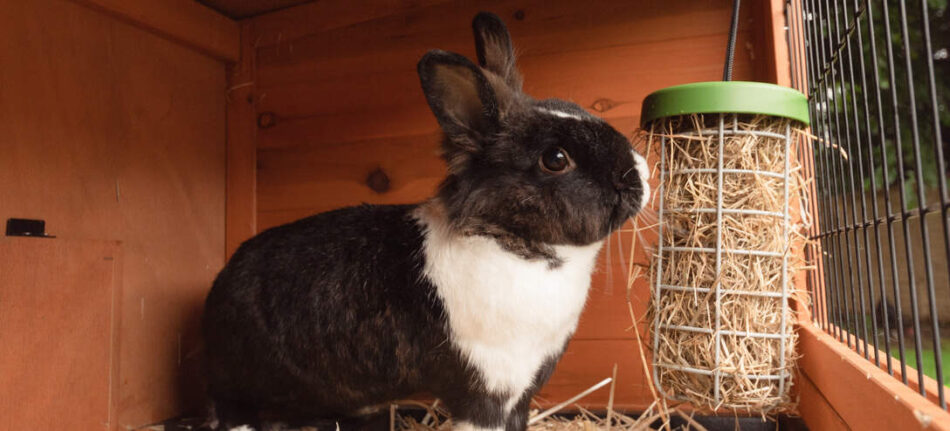
Getting old is part of life. A healthy rabbit will take it in their stride, though, as long as you pay attention to the little details that make all the difference.
This entry was posted in Rabbits on February 22nd, 2021 by juliakretzner

Taking your dog on a long walk is one way to help you both relax, but sometimes, it isn’t always possible to get outside, which means finding other ways to stimulate your furry friend from the comfort of home. Introducing doga…
What is Doga and what do you need?
You’ve probably already heard of yoga, but what about doga? Born in the United States in the early 2000s, dog yoga, AKA doga has quickly spread across the globe. This activity is an opportunity to spend some quality bonding time with your dog and keep fido entertained.
To begin your doga journey, you’ll simply need a yoga mat and a comfortable outfit! This sport can be practised outside, but if the weather isn’t looking great, it’s just as fun to have a go indoors, too! If you do choose to carry out your session inside, make sure to stick to a room your dog feels comfortable in and is familiar with. Having a routine for your dog gives your pet confidence, and they’ll soon associate the yoga mat and the room with spending a moment of relaxation just with you.
The benefits of doga
Doga largely incorporates the benefits of yoga: relaxation, concentration, meditation, and refocusing on yourself. And when done with your dog, it brings new advantages.
Make your dog’s day more zen
Our dogs know when we’re stressed, and picking up on these behaviours in turn affects their mood, too. But, by taking time to breathe and relax with a spot of doga, both you and fido can destress.
There’s no specific doga rulebook, which means tailoring your sessions to meet you and your dog’s needs. If during the earlier sessions, your pup would prefer to stay by your side without joining in, don’t force them. Remember – it’s supposed to be fun for you both.
Learn to speak dog
Well…kind of! Guiding your dog throughout the doga session means taking the lead and communicating to your dog what you would like them to do, just as you would teaching them a new trick. Repetition is the key to a successful session with your dog and adding this new activity to your schedule will be an opportunity for you to enjoy your dog’s company while strengthening how you interact with one another.
Improves sleep
Dogs love to sleep and we know just how important it is for them to get plenty of shuteye. If your dog is struggling to settle into a sleeping pattern, a physically and mentally stimulating activity like doga is one way to help them out. And don’t forget after a workout session to treat fido to a dreamy Omlet Dog bed to upgrade their sleep to another level!
Can my dog do doga?
Doga is made for all types of dogs – young, old, large, and small! Doga can be especially useful for older dogs or dogs that suffer from arthritis. But please note, if you have any concerns about your dog’s condition before beginning doga, consult your vet. Stretching, if done correctly, and massages can have real positive impacts on your dog’s body.
How to practice doga
To get started, take a look at our top book recommendations and videos for the best ways to practice doga.
It’s essential to spend time with your dog so that they can develop to their full potential. Just doing one doga session alone won’t suddenly improve your relationship with your pet pooch, but once you establish this activity as a routine not only for you but also for your pet, you may well be surprised at the benefits you can derive from it.
In addition to this fun activity, don’t forget that the well-being of your dog depends on a balanced diet, daily walks and special attention to their needs.
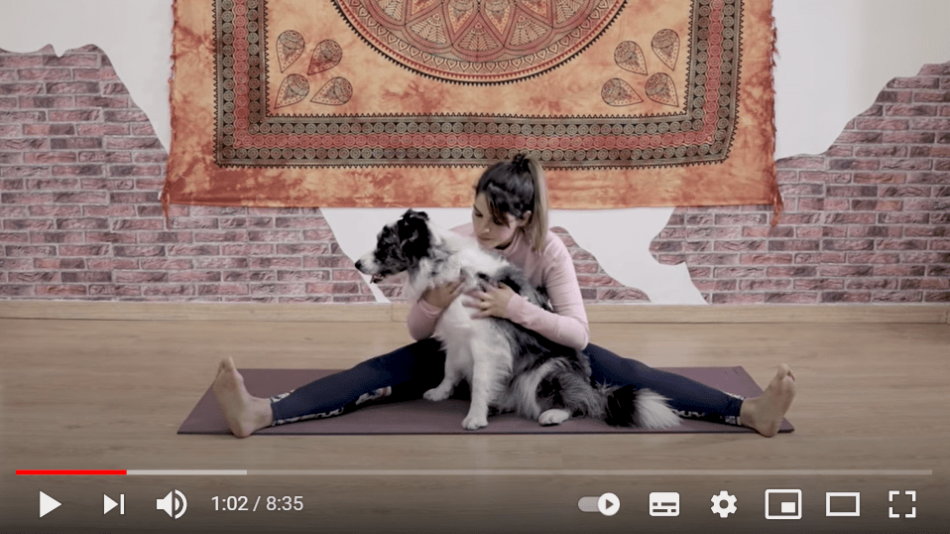
This entry was posted in Dogs on February 19th, 2021 by alisa.deluca
Whether you’re a beginner or experienced chicken keeper, we have put together a list of 10 essential products you should consider having to hand if you decide to keep chickens in your garden.
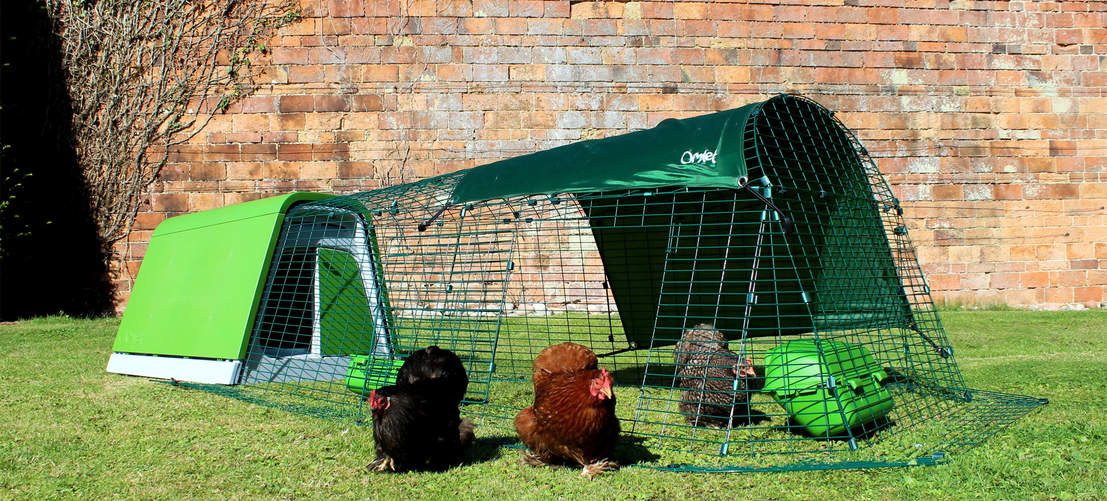
Certain accessories and equipment are essential to keep your chickens safe and healthy.
The products to have on your shelves
Diatomaceous earth: a must!
Diatomaceous earth is a natural and completely organic product which can be sprinkled in the chicken house to prevent the proliferation of red mites. You can also treat your chickens by mixing it with their feed, or dusting them with the powder and incorporating it into their dust bath.
A coop disinfectant
The shelter, equipment and accessories of your chickens must be cleaned regularly to keep their home hygienic and healthy. Use a pet safe disinfectant, like Battles.
Cider vinegar has many benefits
A little cider vinegar in your chickens’ water will help to improve their respiratory system, boost their immune system and maintain a healthy digestive system. Warning: do not use cider vinegar in metal drinkers. This breaks down the metal and can create a toxic chemical reaction for your chickens. Want to clean your eggs but water is not enough? Use the cider vinegar by dipping your eggs in it for 10 seconds. They will be impeccable! You can even add cider vinegar to the water before washing your chickens. Finally, clean your drinkers and equipment with apple cider vinegar to remove traces of limestone. Vinegar is a whitener and a very good disinfectant.
Grit
Having grit on your shelf is essential. Your chickens don’t have teeth, so grit helps your chickens digest the grains and other foods they eat more easily. The ingestion of grit is a physiological need essential for the good health of your flock.
Food supplements
Chickens eat a lot and tend to peck at the ground in search of small insects, but did you know you can buy dried insects, rich in vitamins and nutrients, to support your chickens’ diet?A chicken eats an average of 120 g of food per day. Food supplements can be great for maintaining your chickens’ health and egg production, and providing them with their daily dose of vitamins. For example, chickens need calcium and phosphorus to produce quality eggs which can be supplemented with Equimins Egg Shell Improver. This is ideal for ex battery chickens. Garlic powder is recognised for its many virtues. Added to the daily feed of your chickens, it will improve their immune system, deworm and eliminate red lice and mites.Did you know that herbs are great for their immune system and that it protects your chickens from infections and intestinal parasites? A herb treat mix will support their health and happiness!
Vaseline/Petroleum jelly
If your chicken loves going out for a run in winter. It is advisable to coat the comb with petroleum jelly/vaseline to prevent frostbite.
Scaly leg spray
To prevent unwanted parasite invasions on your chickens and particularly leg scabies, do not hesitate to invest in a scaly leg spray. This form of mange is caused by a mite and can kill your hen. As soon as symptoms appear, growths, yellowish legs, deformation or enlargement of the leg, treat the affected areas immediately.
Gentian Violet Spray:
It is necessary to have a small first aid kit on your shelf in case of small injuries. An antiseptic spray is very effective against small abrasions or wounds from feather pecking.Egg boxes: Having chickens is great, having eggs is even better! Keep them safe after collecting them with egg boxes, just like in the supermarket, or stylish Skelters where you can display them proudly in your kitchen, and keep them in date order.
Bumpa bits
Pecking in chickens is quite common. They can sting with their beaks on the heads of other hens, pluck the feathers, or simply sting the other hen until they bleed. It is a habitual and frequent behavior, it can be caused for the sake of hierarchy or for any other reason: heat, food… In the event of a big crisis in your flock, you can opt for an astonishing solution: bumpa bits. Installed on the beak of your bird, the clip will prevent your hen from pecking and harming the other birds. The end of the spout does not close completely and allows your hen to drink and eat safely.
This entry was posted in Chickens on February 17th, 2021 by alisa.deluca
Guinea pigs are small animals that are increasingly finding their place in homes. Affectionate, they will make your children happy. However, in order for them to flourish at their best, it is necessary to take care of your pets by meeting their needs perfectly. The health of your pet depends on vitamins and a specific diet.
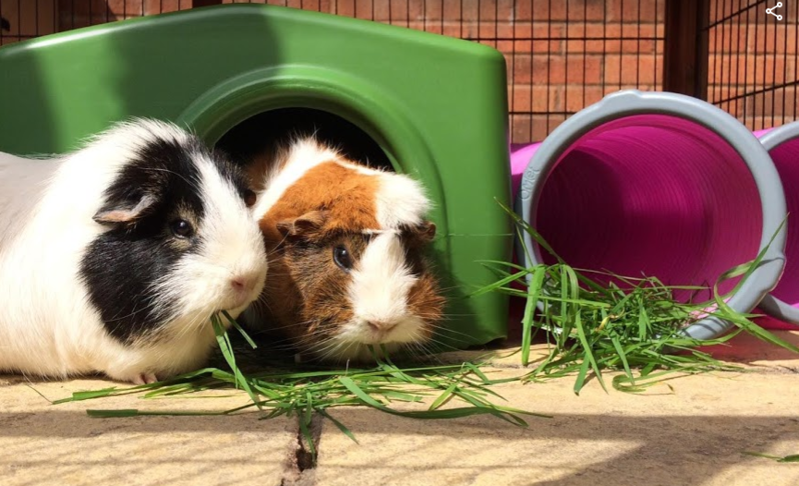
Follow our advice to ensure that your guinea pig receives an adequate daily intake of vitamins and stays healthy.
Why should I give my guinea pig vitamin C?
Just like humans, guinea pigs do not synthesize vitamin C (also called ascorbic acid). Due to an old genetic mutation, our favorite little pets can no longer make vitamin C from glucose. The intake of vitamin C in their diet becomes a necessity.
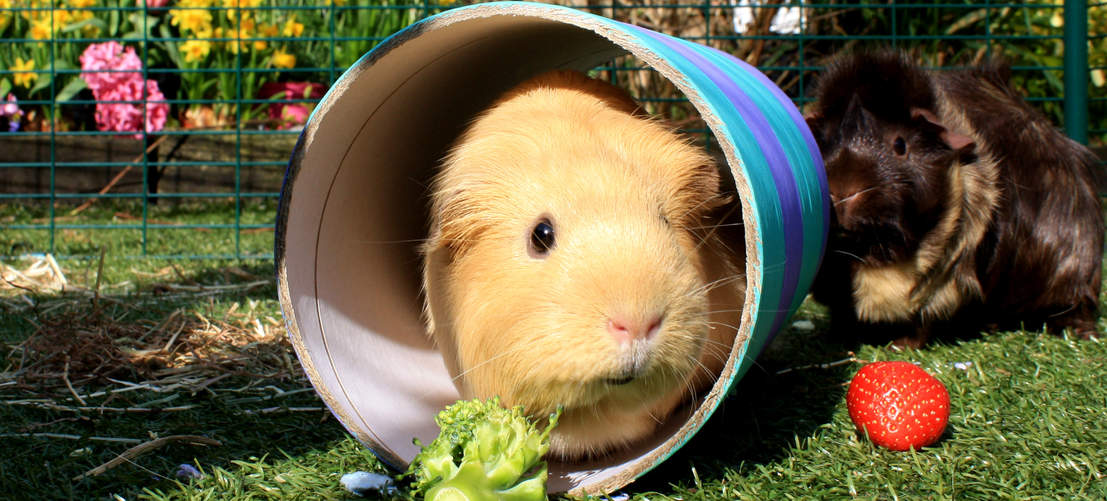
Vitamin C is a molecule that slows down the aging of cells, helps prevent the risk of infections and accelerates healing, therefore, vitamin C intake should not be taken lightly since deficiencies can cause serious health problems in your pet.
The signs of vitamin C deficiency are plentiful and here is what should alert you:
- Your guinea pig is losing weight, does not want to eat or eats differently
- For young guinea pigs growth retardation may be visible
- Your guinea pig’s immune system slows down which can cause many infections. There are also problems with the joints and difficulties for moving. It is important that you be alert to any lesions or sores that may have difficulty healing. If your guinea pig squeals when you pick him up, that’s not a good sign.
Should I give my baby guinea pig vitamin C?
The answer is yes. It is recommended that you give your guinea pig the vitamin from an early age so that it does not suffer from deficiencies.
In addition to vitamin C, which we will focus on in the rest of our article, your guinea pig also needs its dose of vitamin E. Much less mentioned than the previous one, vitamin E is also necessary for maintaining the good health of your pet. If your guinea pig is deficient in vitamin E it may be suffering from muscle problems and this may also be the cause of high mortality in female guinea pigs. This vitamin participates in the production of cells, it therefore has an essential role.
A little tip for vitamin E: between 3 and 5g of vitamin E should be contained in 100g of food.
Foods rich in vitamin E: fennel, broccoli, tomatoes, spinach, peppers and oatmeal.
What foods naturally contain vitamin C?
Many fruits and vegetables contain vitamin C. These foods are easily found in the supermarket. It’s even better if they come from your small vegetable garden! Always wash vegetables and fruit before feeding them to your guinea pig. It is important to present them to your pet as a treat, he will appreciate it more. Do not hesitate to vary his diet by offering different vegetables according to the seasons.
Key figures: the daily intake of vitamin C in guinea pigs should be 20 mg / kg of body weight for an adult guinea pig. This dose can rise to 60 mg / kg of body weight for a growing guinea pig, a pregnant female or a sick guinea pig. If you want personalised advice for your guinea pig, do not hesitate to ask your vet.
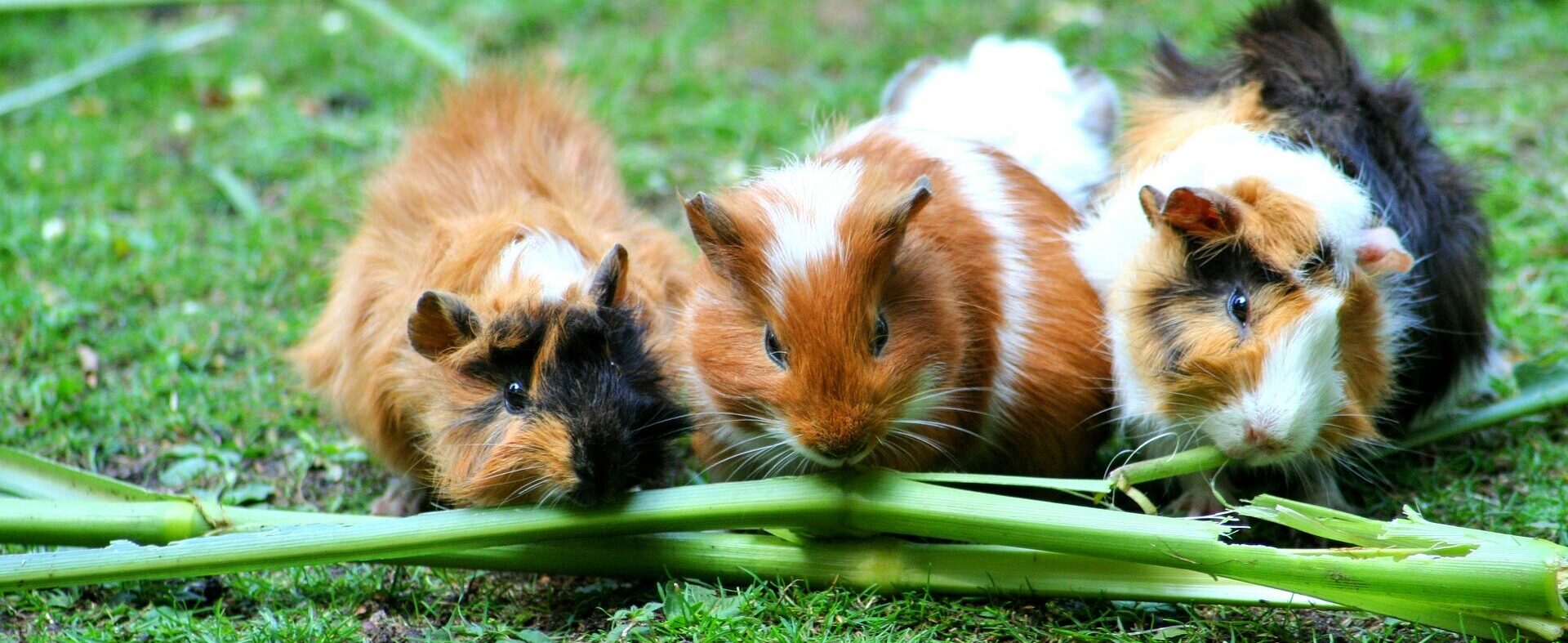
Foods rich in Vitamin C suitable for guinea pigs in 150 g portions (be aware, it is not a question of giving 150g of the same vegetable but of varying the plate):
- Horseradish:contains 141 mg.
- Parsley: contains 140 mg.
- Kale: contains 120mg. Be careful, this food should be eaten in moderation since it may cause bloating in your animal, just like other types of cabbage (Brussels sprouts, cauliflower, white cabbage, red cabbage, green cabbage, etc.)
- Fennel: contains 120 mg.
- Red Pepper: contains 126 mg. Red peppers contain more vitamin C than green peppers.
- Broccoli: contains 93 mg.
- Dandelion: contains 58 mg.
- Chicory: contains 24 mg.
- Radishes: contains 23 mg.
- Tomatoes: contains 19 mg. In addition to providing vitamin C, they are rich in water.
- Zucchini: contains 10 mg.
- Celery: contains 7 mg.
- Cucumbers: contains 5 mg.
This list is not exhaustive, but gives you an overview of foods rich in vitamin C which you might already have at home! We advise you to vary your intake and ask your vet for more information.
Small dietary reminder: do not feed guinea pigs rhubarb, onions, leeks, chives, garlic, avocado and lettuce (rich in nitrate) and avoid carrots as they are often too sweet.
We often forget it, but grass is also a source of food for guinea pigs as it is a complete food. You can also supplement the diet with leaves of strawberries, raspberries (beware of thorns), mulberries, willows…
Fruits must also be integrated into their diet, but be careful as they are highly concentrated in sugar and should be given in moderation.
Sometimes, despite a varied and balanced diet, vegetables and other plants are not enough. Guinea pig owners are therefore advised to provide them with vitamin C supplements.
How to give vitamins to my guinea pig? In what form should they be favored?
Vitamin C is available in a variety of forms so you should be able to find something to suit your guinea pig’s preferences. Just like humans, some will prefer capsules while others prefer a liquid form.
Liquid form: Ask your vet for advice on the brand you should choose. The vitamin is injected with a syringe. This method is complex because you have to succeed in getting your guinea pig to ingest the desired dose by placing the syringe in the side of the mouth. Avoid putting it face-on or pushing it into his mouth, he could choke. Do not put vitamin C in liquid form in water. Vitamin C is sensitive to light and air, and could break down very quickly. Protect the bottle from light and recap the bottle quickly after use.
Capsules / tablets: this is an effective way to make sure that your guinea pig is getting its daily amount of vitamin C. There are brands on the market that allow you to get the optimal dose. If your guinea pig has difficulty swallowing the tablet. You can hide it in a banana for example, or in other fruits that your guinea pig enjoys.
Powdered: This form of vitamin C should be taken with caution. The powdered sachet, once opened, must be quickly consumed by the guinea pig or the benefits may be lost. Powder on contact with air will simply lose its effectiveness. The powder has a positive though; you can put it on a piece of cucumber or another treat that your pet loves, the vitamin will then be easily ingested.
Vitamins C and E should be supplied throughout the life of your guinea pig. However, avoid overdosing. Indeed, too much vitamin C can also be dangerous for your animal and cause urinary stones. Check with your veterinarian for the exact dose of vitamin C to give your guinea pig, to help him/here stay in great shape to live life happily and healthily.
This entry was posted in Guinea Pigs on February 13th, 2021 by alisa.deluca
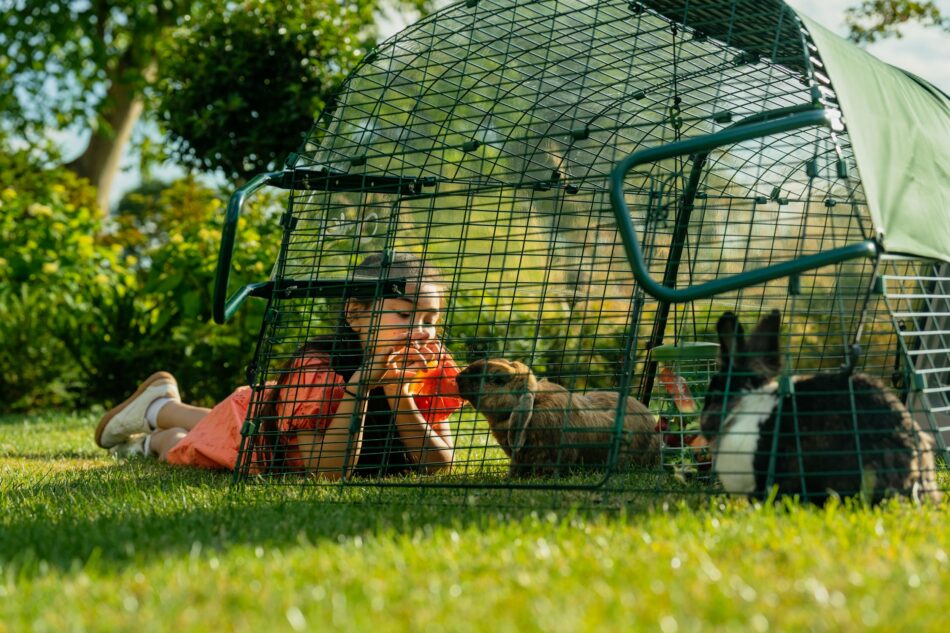 Did you know that rabbits can enjoy a variety of fresh produce? In addition to their dietary staples, bunnies can safely nibble on nutritious garden vegetables and small amounts of fruit. Find out what fresh produce you should be feeding your rabbits, how much, and the benefits of offering them fresh treats.
Did you know that rabbits can enjoy a variety of fresh produce? In addition to their dietary staples, bunnies can safely nibble on nutritious garden vegetables and small amounts of fruit. Find out what fresh produce you should be feeding your rabbits, how much, and the benefits of offering them fresh treats.
What should I feed my bunnies?
First and foremost, rabbits should be fed a quality pellet diet made up mainly of timothy hay. The protein content should fall between 12-16% for most breeds of rabbits, and the fibre content should be at least 15%. Free choice access to loose timothy hay should always be available to help keep their digestion moving smoothly and keep their front teeth trimmed through continuous gnawing. Your rabbits should also have access to fresh, clean water at all times, which thanks to the Eglu Go Rabbit Hutch, is made easy. Simply open the single large door at the back of your rabbits’ enclosure to reveal the bedding tray and access the complimentary hay rack and water bottle.
Anything that’s offered in addition to these dietary staples should be considered treats. Fresh produce is a much healthier alternative to pre-packaged rabbit treats that are commercially available, but should still only be offered a few times a week. Rabbit-safe fruits can also be offered, but in moderation, as they are high in sugar. These foods are not readily available to wild rabbits – and while your domesticated bunnies may have all of their needs provided by you, their digestive system is still very similar to their cousins in the wild. By replicating the diet that rabbits stick to in the wild, you’ll help your pet bunnies maintain a healthy lifestyle.
Rabbit-safe fresh produce
There are several rabbit-safe foods that can be found in grocery stores, home gardens, or even in your own backyard. Fresh produce should be served in a separate feeder than their regular diet to keep their run clean. A hanging treat holder is perfect for serving up fresh foods to keep them away from insects and to give your rabbits a new angle on snacktime.
Some fresh produce is healthier than others, while some should be avoided entirely. This list isn’t comprehensive, but it includes the most common fresh produce that can be offered to rabbits.
Vegetables
Veggies can be offered several times a week, with a few exceptions. Spinach contains oxalic acid, which in high amounts can cause digestive upset in rabbits. Sweet potatoes are also a favorite among bunnies, but are very starchy, so they should be offered sparingly.
Vegetables that are safe and nutritious for rabbits include:
- Asparagus
- Bell pepper
- Broccoli
- Brussel Sprouts
- Cabbage – red, savoy and kale
- Carrot tops (more on carrots later)
- Cauliflower leaves and stalks
- Celery
- Chicory
- Cucumber
- Lettuce – romaine or green leaf
- Parsnip
- Radish
- Spinach (no more than once a week)
- Sweet potatoes (sparingly)
- Turnips
- Watercress
- Courgette
Carrots – not a rabbit’s best friend
Rabbits are so closely associated with carrots that it’s hard to fathom that they might not actually be that good for them. From Peter Rabbit to Bugs Bunny, fictional rabbits love carrots – and real bunnies love them too. But, carrots are high in sugar and calories, but lack the fibre needed for a rabbit to digest them properly. A carrot-heavy diet can cause constipation in rabbits, and make blood sugar levels rise dangerously. Carrots should be fed as fruits are – fine as an occasional treat, but only offered in moderation.
Fruits
Fruit should be offered in small amounts, no more than 1-2 times per week. Don’t offer fruit to rabbits less than 7 months of age, as their young digestive system may be upset by the sugar content.
Rabbit-friendly fruits include:
- Apples
- Bananas
- Berries – Blueberries, blackberries, raspberries, and strawberries
- Kiwi
- Melon (without the rind) – cantaloupe, watermelon and honeydew
- Pears
- Tomatoes
Herbs and plants
Wild rabbits eat a wide variety of plants, and even wood and bark. There are many forage plants that you can feed your pet rabbits, but not all native fauna is fair game. Never offer a wild plant to your rabbits unless you’re confident in identifying safe types. And, always make sure that wild plants haven’t been sprayed with fertilizers or pesticides – most of which are harmful or even fatal to rabbits.
Herbs and plants that are safe for rabbits include:
- Basil
- Berry leaves – blackberry, raspberry and strawberry
- Clover
- Dandelions – flowers and stems
- Dill
- Grass – fresh stalks, not lawn clippings that may contain other plant matter
- Mint
- Oregano
- Parsley
- Plantain
- Rose – leaves, petals, and stalks
- Rosemary
- Sunflowers
- Yarrow
Dangerous plants and vegetables
Some fresh foods are bad for bunnies. These plants affect your rabbits in many ways, ranging from mild discomfort to being toxic even in small amounts. If you suspect your rabbit has eaten any of the following, keep a close eye on them and call your veterinarian if you notice any unusual behaviour.
Never feed your rabbits:
- Aubergines
- Avocados
- Bamboo shoots
- Beans
- Chives
- Garlic
- Iceberg lettuce
- Nuts
- Onion
- Peas
- Potatoes (sweet potatoes are fine)
- Rhubarb
- Tomato leaves (in large quantities)
Feeding your rabbits with Omlet
Finding fresh produce for your rabbits is a fun way to diversify their diet and deepen your bond with them. Offering their fresh foods in a Caddi Rabbit Treat Holder keeps their rabbit hutch and run clean and reduces potential waste. Or, build your bunnies a custom burrow with our Zippi Rabbit Tunnel System and strategically place their snacks along the way. However you choose to treat your pets, we’re here to support your rabbits’ healthy habits.
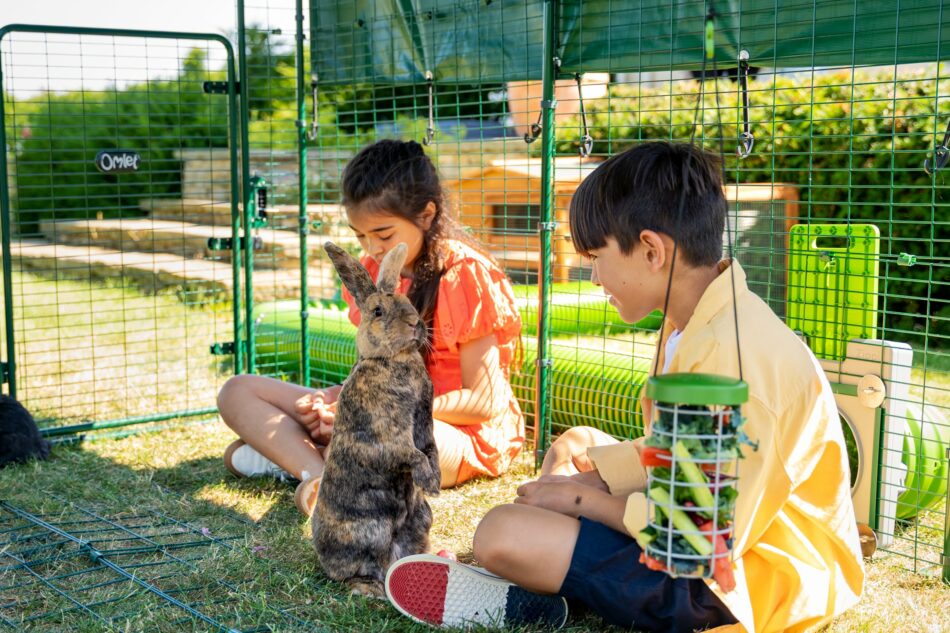
This entry was posted in Rabbits on February 9th, 2021 by emmaibadioune
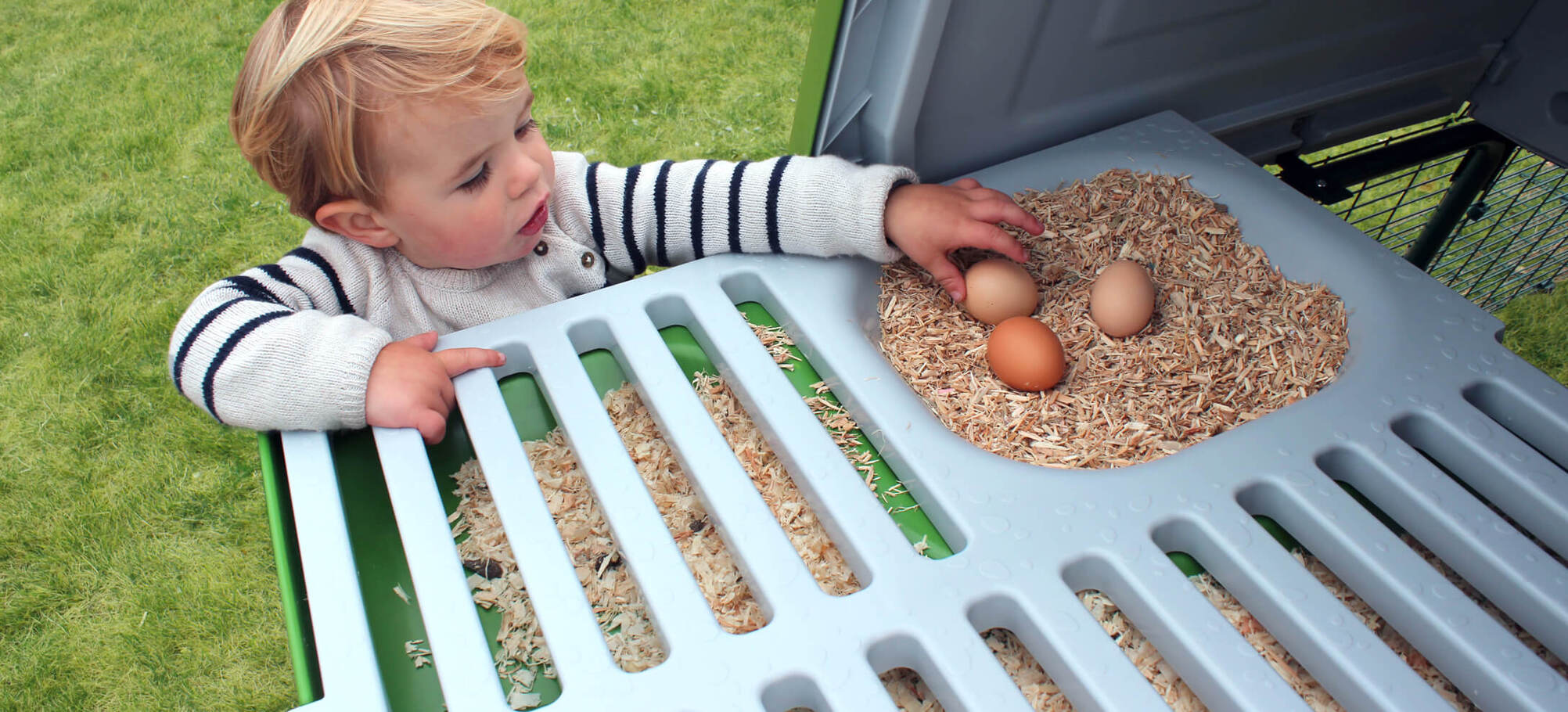
Enjoy collecting fresh eggs from your Eglu chicken coop!
A fresh egg every day – that’s just one of the best things about having your own flock of chickens in your garden. But it’s not that simple. For the private keeping of chickens, there are some legal frameworks and conditions you must take into consideration – and those may differ from country to country.
To receive the most accurate and timely information and policies to avoid obsolete and incorrect information, please always contact the responsible authority for a local law and/or ordinance regarding livestock and poultry or an official veterinarian as a first point of contact.
Do you need to register your chickens?
Depending on the country you live in, you might need to register your chickens. In some countries, like the UK or U.S., you must register your chickens within one month by using the compulsory registration form if you keep 50 or more birds in your premises. This is important, as if you don’t register your chickens, you’re breaking the law. The law also applies if you keep flocks made up of different species, – chickens, ducks, geese, guinea fowl, patridges, pheasants, pigeons or turkeys – and birds for the consumption of meat and eggs.
In Germany, every single chicken has to be registered directly on the first day with the responsible veterinary office and must be reported to the animal disease fund. This applies to all types of poultry. This is important in order to reduce the risk of spread of an epidemic quickly and efficiently.
How many chickens make a perfect flock?

To answer this question, one major consideration is how much space you have for your chickens and how many eggs you need.
As a mature hen lays about two eggs in three days on average, keeping three to six chickens will ensure you always have a steady supply of eggs for your family. However, if your family really loves eggs or plans to give eggs away occasionally, you may wish to consider expanding your flock.
In general, it’s good to start with at least three chickens – if there’s an unexpected death, you won’t be left with a lonely one. In a breeding flock, a rooster will need four to six hens.
Space requirements of chickens vary depending on the size and breed of the chicks, and how long you are free ranging the chickens during the day. Although it is recommended to have a minimum size of 2-3 square feet per hen, please keep in your mind, the bigger, the better!
Nevertheless, it is important to have an outdoor enclosure, like the Walk In Chicken Run, to keep your chickens safe from avian predators. Another good defence against unwanted “night visitors” is a chicken coop door. If you come home late in the evening and need an alternative way of closing them safely inside, an Automatic Chicken Coop Door is recommended. With the control panel you can set the automatic door so that it opens and closes the coop at a certain time or based on the rising and setting sun.
The Omlet Autodoor opens horizontally, meaning it cannot simply be lifted up when it is closed by predators, so you and your chickens can sleep peacefully knowing that you have the safest automatic chicken door in the world.
If you have ground predators, you can also protect your flock with an electric poultry fencing.
Do my chickens need to be vaccinated?
Different countries have different requirements for poultry vaccinations, so check with the government environmental website or a local vet for advice. However, there are some diseases you should be aware of and may consider vaccinating against, such as the Bird Flu (e.g. Avian Influenza), Newcastle disease and Marek’s disease.
Bird Flu can infect domestic poultry and other bird and animal species. In the worst scenario, if e.g. the avian influenza affects a flock, the flock has to be put down. These viruses do not normally infect humans. For more information, please visit our blog article What You Need To Know About Avian Flu.
The Newcastle disease can vary from mild to severe and unfortunately, there is no treatment for Newcastle disease yet – but when given between 14 and 21 days of age, a vaccine can help to prevent this disease. Newcastle disease is also transmissible to humans.
Marek’s Disease is caused by a chicken herpes virus and affects the chicken’s central nervous system. Like many herpes viruses, once an animal becomes infected, it will be infected for life. However, not all infected birds will get sick. This disease isn’t contagious to humans.
For the health and safety of your chicken and flock, and to prevent the risk of spread, it is definitely recommended to vaccinate them. Especially if you plan to sell or buy chickens, you need to vaccinate your hens.
And remember: always isolate new flock members for at least 30 days!
Do I need permission for chicken keeping?
Depending on where you live, some cities and towns have restrictions and regulations on chicken keeping, for example, the number of chickens that can be kept, the minimum and maximum size of the coop in which the chickens will be housed or a minimum distance to the neighbouring property. Some areas prohibit the keeping of roosters due to the extra noise; others require that all chickens be leg-banded for identification purposes.
However, you may also be subject to by-laws, lease conditions or the deeds to your house preventing you from keeping chickens, and there are rules that may apply to back-garden poultry keepers, so be sure to check your local restrictions before buying chickens.
In addition, you might want to consider your neighbours when raising chickens. Although lots of people will be won over with the promise of fresh eggs, it might be a good idea to check with your neighbours first, and assess your gardens to ensure you’ve done all you can to prevent your hens hopping over to their vegetable patch!
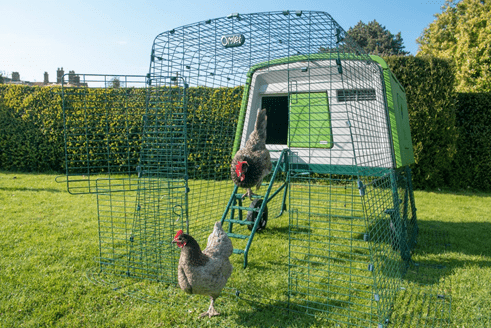
The Omlet Eglu Cube houses up to 6 large hens or 10 bantams!
What are other considerations of keeping chickens in my yard?
Some regulations require you to meet some minimum requirements. In Spain, for example, the legislative provisions stipulate, you need to keep the noise level as low as possible, the chicken coop must be well illuminated and regular veterinary care must be provided.
Most suburban councils will limit the number of birds you can keep or even prohibit roosters on residential properties due to the disturbance they could cause to neighbours.
Australia is an interesting example of how different local restrictions can be. In Victoria, residences with backyards can have a maximum of five chickens, whereas New South Wales allows no more than 10 chickens in residential areas. In Western Australia, owners can keep up to 12 poultry birds. Furthermore, it is prohibited to keep roosters in general in Queensland, New South Wales and Western Australia.
Even the height of the perch where your chooks sleep on is set at around 30 cm off the ground.
Although there are many different regulations and laws when it comes to chicken keeping, there is one inevitable rule which applies to all countries and local areas: chickens need access to fresh bedding, food and water at all times!
Always be sure you are in accordance with local ordinances and up-to-date before embarking on your chicken-keeping endeavor, especially as policies and law can change. Obtaining information such as the correct local hen house keeping (farming method for laying hens) or the examination of species-appropriate hen houses is important, – each country has its own animal welfare requirements and regulations, and should not be ignored.
This entry was posted in Chickens on February 8th, 2021 by emmaibadioune
Dementia is not a uniquely human condition. Many older pets suffer the condition known as Cognitive Dysfunction Syndrome (CDS), and the effects are often subtle.

Photo by Pacto Visual on Unsplash
The problem first becomes noticeable when pets’ behaviour changes. For example, a dog may not respond to your voice, or will stand with its tail down, looking anxious. Cats may ‘disappear’ for several hours, or even days, and any affected pet may seem suddenly uncertain of its surroundings, sometimes cringing, sometimes running away.
What is pet dementia?
As with human patients, dementia in pets results in memory problems, leading to confusion, disorientation and anxiety. The causes for this are the same as those responsible for Alzheimer’s and other types of human dementia. Destructive proteins may build up in the brain, and these cause individual brain connections to stop working. Plaque build up is another cause, as is a build-up of phosphorus.
Which pets can get dementia?

Cats and dogs are the most common victims of CDS, although other mammals such as rabbits, Guinea
pigs and ferrets may show similar symptoms. Shorter-lived mammals such as hamsters and gerbils are not affected by dementia.
Long-lived birds such as parrots, intriguingly, do not usually show dementia symptoms. Research has shown that they lack a dementia-linked variant of a gene known as GSK, something found in most animals (and even plants). This gene causes the build-up of phosphorous in the brain, and this impacts a protein called tau, which in turn triggers Dementia symptoms.
What are the signs of dementia in pets?
Most animals are very stoical and do not like to let you know when they are in pain. CDS is a different matter, though, as it causes your pet’s natural defences to go down, and you can often spot the tell-tale signs.
These are some of the signs of dementia in pets.
- Confusion. In the middle of everyday activity such as a walk or a trip from one room to another, your pet will become indecisive or may bolt for a safe spot for no apparent reason. Other symptoms include growling, raising the hackles, or shaking.
- Disorientation. Your cat or dog might become anxious, or stop in its tracks, in a familiar place – even indoors where they spend most of their time. Temporarily forgetting where they are, they may feel trapped, and their panicky or fearful body language – or sounds – will make this clear.
- ‘Accidents’ indoors. Pets with CDS may suddenly forget that they’re not supposed to relieve themselves indoors. This is often linked to disorientation and confusion rather than loss of bodily control. They may wake up in the night, thinking it’s time for the morning routine of nipping outdoors for a morning trip to the pet bathroom. Cats might forget the location of the litter tray or cat flap.
- Odd sleeping patterns. A change in sleeping patterns can be a sign of CDS. Dogs may become restless at night, or sleep away from their usual beds or baskets. Outdoor cats may decide to sleep rather than heading out for their usual night on the tiles, or may be restless during parts of the day when they would usually be curled up and asleep.
- Change in personality. Any big change in behaviour in an older pet could be an early sign of CDS. An outgoing pet might become withdrawn, and a quiet pet might be grumpy or aggressive. Affected pets might temporarily forget who certain family members are, or might suddenly treat fellow pets with suspicion.
- Memory loss. This classic symptom of dementia is often the first sign of CDS in a pet. They will stop responding to commands or may struggle with things they have managed for years, such as stairs and the quickest route home on a walk.
- Loss of energy. Although there can be physical sources of sudden ‘laziness’, it is also one of the symptoms of dementia. In addition to not being as active as usual, an affected pet might pace up and down like a caged animal, or stand on the spot gazing around in apparent confusion.
- Changes to vocalising. A quiet pet might start making a lot of noise, or an inveterate ‘woofer’ might fall quiet. There might be an increase in barking or meowing at night.
- Change in appetite. This goes both ways – a pet with CDS might become a glutton (forgetting that they’ve already eaten), or might not want to eat at the usual time at all.
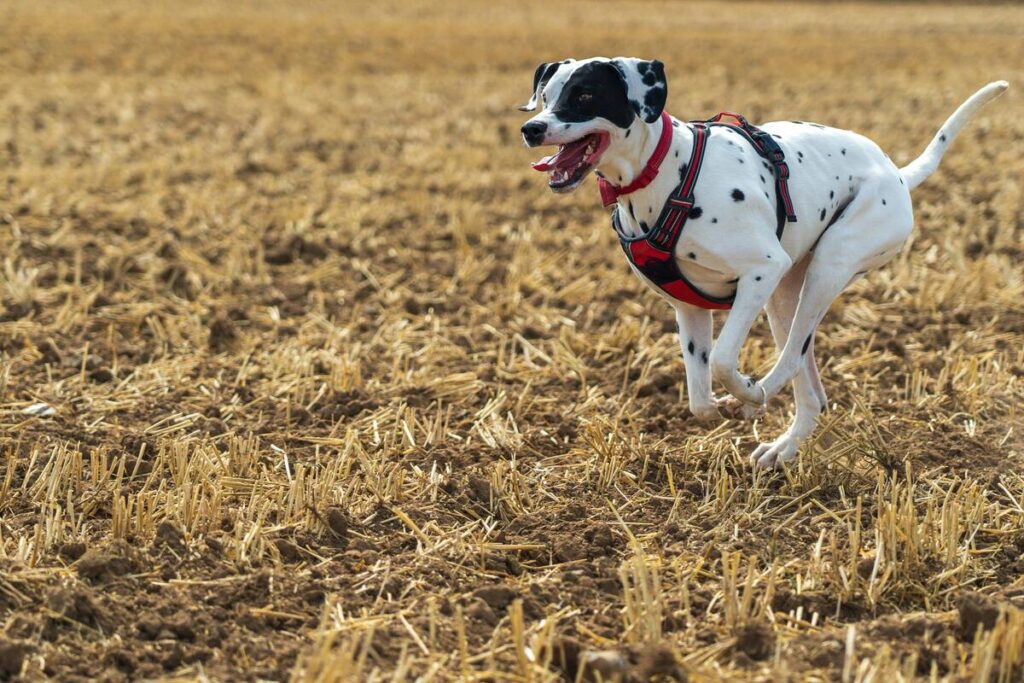
Photo by Nick Fewings on Unsplash
How can I treat dementia?
There is currently no cure for pet dementia, but there are medicines available to help reduce the symptoms and even slow down the progression of the illness as your pet ages. These treatments are only available from vets, so that’s the place to go as soon as you suspect CDS in your pet.
As ever, prevention is an even better cure, and by keeping your pet active and fit through exercise and games, you can help their bodies and brains alike. Diet plays as big a part in this as exercise, so keep the healthy food coming and go easy on the unhealthy snacks. A supplement that includes omega-3 fish oils is very beneficial, too.
Once the CDS has begun to manifest daily, there are still things you can do to make life easier for the afflicted pet.
- Don’t make unnecessary changes in the environment in which the pet spends most of its time. Keep furniture where it is, and don’t make changes to the beds or baskets.
- Remain calm and don’t change your behaviour. If you shout at a cat or dog because it’s soiled the floor, it will only add to the problem and cause your pet’s anxiety levels to rocket.
- ‘Lead the way’ if disorientation sets in, encouraging your pet to follow you into a room, or back to the house. With dogs, a lead should always be taken when you are on a walk.
- Don’t stop family members from interacting with the pet, even if it seems to have temporarily forgotten them.
- Play games that help keep the pet’s brain active, like training (if they can manage it) or puzzle games.
- Try retraining your dog to sit, stay and come when you call – and retrain those toilet skills too, if possible!
If the vet prescribes medication and a change in diet, make sure you stick to the new regime. Interventions that support brain function, including medicines and food supplements, can make a big difference. Although dementia changes a pet’s life, it does not automatically mean that they will stop enjoying life. Think of it as eccentricity rather than a disaster, and you’ll all continue to enjoy a wonderful pet/owner relationship.
This entry was posted in Pets on February 5th, 2021 by emmaibadioune
Cockerels have three main purposes in a flock of chickens. They protect the hens by warning of any danger, they enable you to breed your own chicks, and they look fabulous. Sometimes, however, the cockerel’s protective instincts becomes a problem, and the bird becomes over-aggressive. This can be a particular issue in the spring, which is the breeding season.
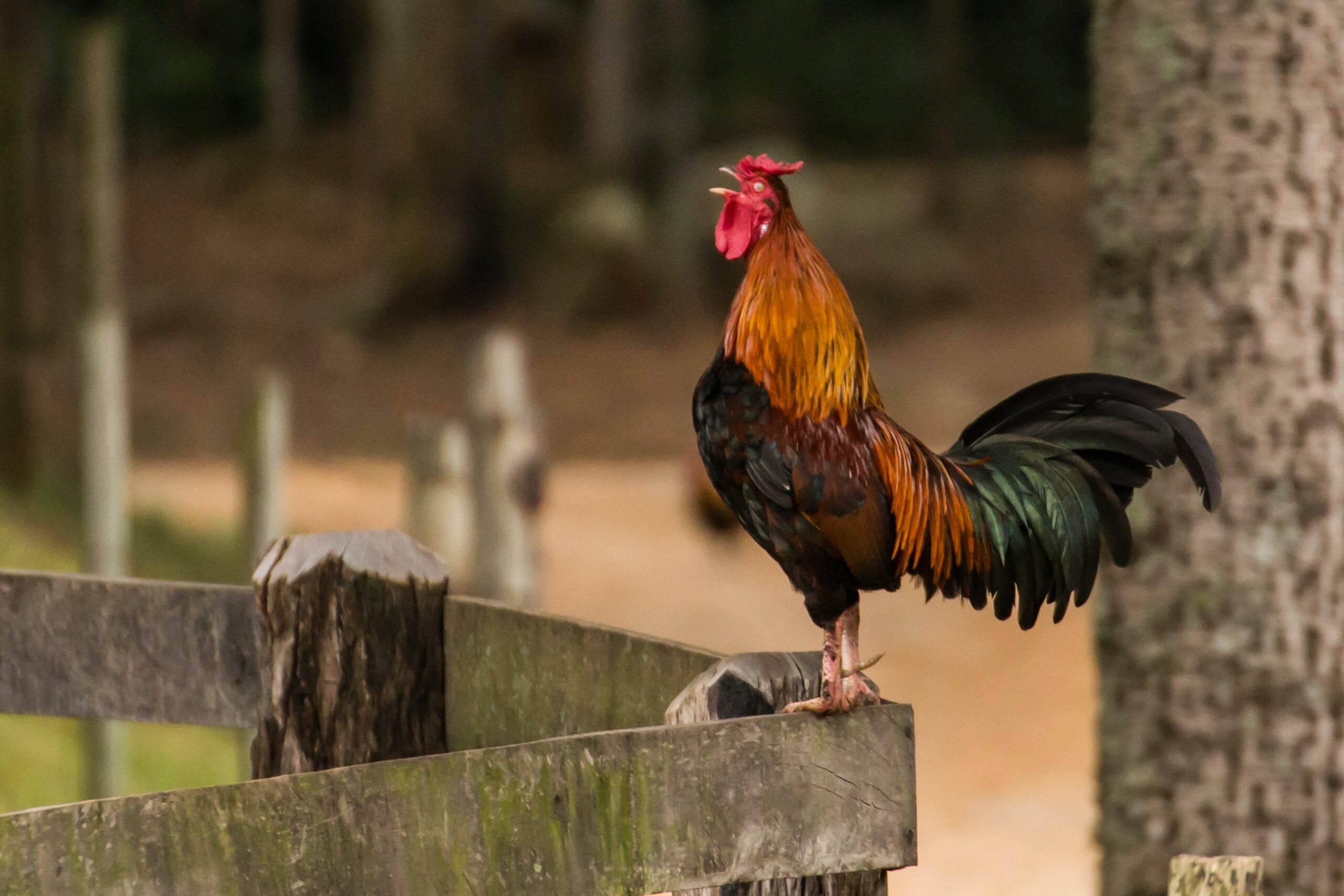
Cockerels are wired to protect their hens. If you watch the flock foraging in a garden, the loud clucking of a hen will bring the cockerel running to make sure everything’s okay. If a hen squawks when you pick her up, the cockerel will put on an aggressive display until you put her down again. As long as this doesn’t involve physical attacks, there’s no problem. Some cockerels will physically attack, though.
If these face-offs continue, the cockerel might decide that you – and all humans – represent danger and will try to fight you off at all times. Luckily, you can usually defuse the situation.
Cockerels give warning of their intention to attack. They lower their heads and perform a strutting dance while looking straight at you. Things get trickier if the cockerel decides to run up and attack your legs, like an angry farmyard goose. If you’re walking away, the cockerel may chase you from the yard, and that can cause nasty surprises too.
How Do You Stop a Rooster From Attacking You?
- Don’t walk straight towards the cockerel when you enter the place where the chickens are kept.
- Don’t stare at the cockerel unless he’s already behaving aggressively, as this is a sign of aggression as far as he’s concerned – you’re fixing your eyes on him and his flock just like a predator would.
- Don’t tiptoe around or run away if the cockerel looks at you, as these are signs that you’re afraid, and the cockerel might take this as a cue to rush in and finish the job!
- Don’t dash around the yard – the cockerel equates quick movements with predators. Go about your business in the chicken yard in a calm, slow but focused way.
- Make sure your hens are in a stress-free environment. If there are prowling dogs or unruly children running amongst the hens, their clucks and squawks will send the rooster into overdrive to protect his girls.
- If your cockerel brings you small ‘gifts’ such as stones or twigs, don’t be too flattered. He is treating you like a hen, and you will have to refuse the gifts and shoo him away, otherwise he will think he’s subdued you with his presents!
- Don’t crowd the cockerel. If he feels trapped in a corner, he is likely to fight his way out.
How to Handle an Aggressive Cockerel
Never respond to an angry cockerel with violence.
This will have no positive effect on the cockerel or flock’s behaviour afterwards, and it can result in serious injury to the bird. He may be aggressive, but a cockerel is still a bird, fragile bones and all.
A cockerel should be lifted with thick protective gloves to remove him to a safe place or away from the eye of the storm. Your arms and legs shouldn’t be bare when handling the rooster, and your footwear should be sturdy too. If the cockerel is only in the early stages of aggression, he can often be calmed down with a few treats. It is a good idea to carry treats with you whenever you’re in the same place as the cockerel. After you’ve fed him a few times, he will come to associate you with treats rather than danger. The treats should be hand-offered. If you throw them down and then run away, the rooster will recognise that you’re afraid, and the problems might continue.
A more hands-on – or feet-on – method is to gently roll the cockerel over with your safely booted foot when he approaches you looking for trouble. After a few of these gentle wrestling throws, the cockerel will realise that you’re the top bird in the run and give you no more trouble. In theory, at least!
How to Lift an Angry Cockerel
Alternatively, when the cockerel tries to peck you, scoop him up with your gloved hands and hold him like you would hold a hen, under your arm. The cockerel will flap and squawk angrily, but he will eventually calm down if you ignore these protestations. This may take 10 to 15 minutes, but it’s time well spent if it means that the cockerel will not attempt to attack you again.
If the cockerel has not yet attacked, you may be able to deter him by taking a large, deliberate step towards him, looking at him as you do so. If the rooster starts to fidget and looks at the ground or starts pecking it, you have won the battle, and you can back down without fear of attack.
The key to all these methods is to make the cockerel realise that you’re not a threat to his hens. Protecting the flock is all he wants to do. If that doesn’t work, and if the cockerel starts to stretch his wings and neck ready for attack, stretch out your arms. Carrying a stick can help here, as it makes your ‘wingspan’ look even greater in the rooster’s eyes.
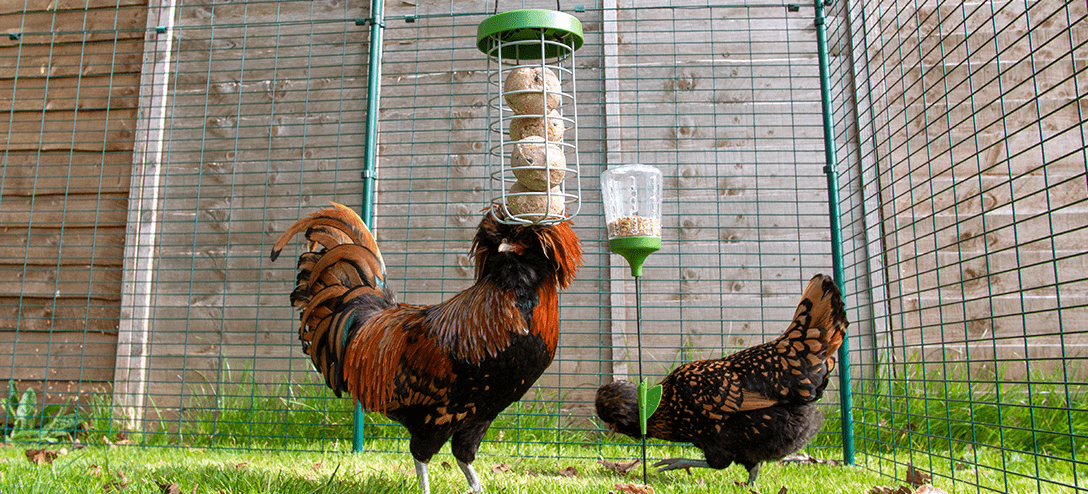
Treat holders and peck toys will keep your chickens entertained for hours!
What is the Most Aggressive Rooster?
Circumstantial evidence suggests that some cockerels are just born mean! In these cases, the cockerel’s instinct to protect a flock of hens is in constant overdrive. The aggression is occasionally seen when the birds are still chicks, although it is more usual for the aggression to kick in at 6 to 8 months old. Although the breed of the chicken makes a certain amount of difference, even supposedly gentle breeds can sometimes decide to take no prisoners in the chicken yard!
The most aggressive rooster breeds are said to be Aseel (allegedly the biggest bullies of all), Cornish, Leghorn, Malay, Old English Game and all other traditional ‘cockfighting’ or ‘game’ species.
What is the Least Aggressive Rooster?
The least aggressive roosters include the Australorp, Brahma, Polish, Silkie and Welsummer. Bantam breeds tend to be relatively calm, too. However, there are occasional ‘bad pennies’ in all breeds, and some cockerels just seem to hit an aggressive streak and never entirely leave it behind.
Constantly aggressive roosters are a real problem, especially if you have children wandering in the garden. A cockerel readily backs up his anger with a physical attack, and he is armed with sharp spurs – the spikes on his legs – that can do real damage. If all attempts to calm the cockerel down fail, the tyrant rooster will have to be rehoused.
If you have chosen a non-aggressive breed of cockerel, and if your chickens have lots of space, you will seldom have major problems with rooster aggression. Let cockerels know who’s boss as soon as they hit adulthood, never accept those tempting little gifts, and you should be recognised by all your chickens as being top of the pecking order.
This entry was posted in Chickens on February 2nd, 2021 by emmaibadioune
 Photo by Andrea Lightfoot on Unsplash
Photo by Andrea Lightfoot on Unsplash Chicks need special accommodation for the first few weeks, and they can’t simply be kept in a standard coop and run. You can buy brooder boxes to keep them, or you can improvise one using a cardboard box or plastic bin with holes in the side. The important thing is to keep the birds warm and protect them from drafts while ensuring good ventilation. You will need two square feet per chick to ensure they have enough room when they get bigger – which they will do, very quickly.
Chicks need special accommodation for the first few weeks, and they can’t simply be kept in a standard coop and run. You can buy brooder boxes to keep them, or you can improvise one using a cardboard box or plastic bin with holes in the side. The important thing is to keep the birds warm and protect them from drafts while ensuring good ventilation. You will need two square feet per chick to ensure they have enough room when they get bigger – which they will do, very quickly.

















